Life in a lab
Plans, dreams and day-to-day work for a team studying the sense of touch
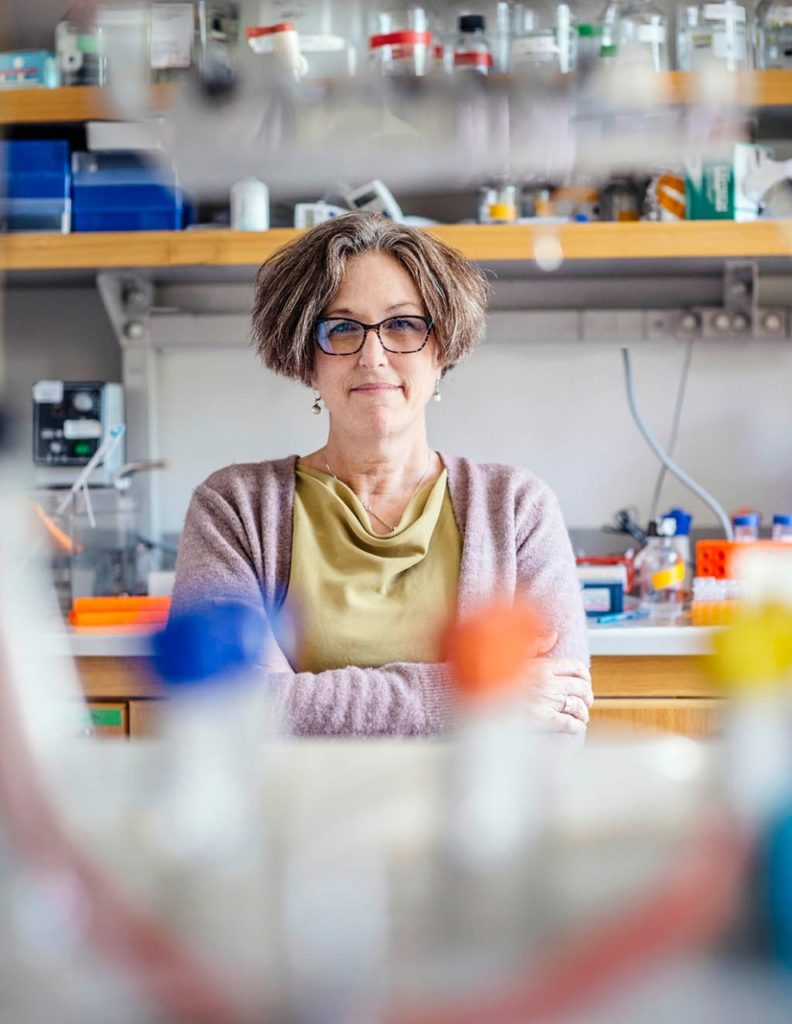
The first thing Joy Franco does when she gets into the lab in the morning, ordinarily around 8, is check on her worms.
“Usually the building’s pretty empty,” Franco said, and it wouldn’t be hard for her to just mill around. Instead, she gets to work.
“I remind myself of all the strains that I’m working on. I check where they are in their aging and development, and plan out my experiments. I come up with a to-do list, a very tangible to-do list, tractable items like, ‘Feed these worms.’ And then it’s just crossing things off, because the list is always longer than there is time in the day.”
Online extra
Alakananda Das, a postdoctoral fellow in the Wormsense Lab, talks about how much she loves bench science, even when it’s frustrating.
In some respects, Franco and her lab mates’ jobs sound pretty typical. They check on the status of different projects, they make lists, schedule events and appointments, and so on.
Were it not for the part about the worms, it would be easy to miss that the group, led by Miriam Goodman, PhD, professor of molecular and cellular physiology, are researchers in a neuroscience lab. Even with the worms, it would be easy to miss their purpose: They study the sense of touch, something we often take for granted.
“How touch shows up in our lives is actually really important,” Goodman said. “In the morning, when I can’t really open my eyes, I can reach over and hit the snooze button or pick up a cup of coffee without seeing it. And that’s because I have an intact sense of touch.”
Yet the sense of touch is not well understood, so Goodman’s team in Stanford’s Department of Molecular and Cellular Physiology is working to better understand it, using as a starting point touch-sensitive neurons in a tiny worm called Caenorhabditis elegans — they’re easier to study than humans, Goodman said, but complex enough that there’s something useful to be learned by studying them.
And learn they have. In recent years, the researchers in Goodman’s laboratory have explored several aspects of touch, including the sensing of pain, pressure and temperature, often in collaboration with mechanical and chemical engineers. They have studied how individual neurons translate touch’s mechanical force into electrical and chemical signals to other neurons and cells.
They’ve studied how those neurons survive the skin’s daily grind of stretching, squeezing and pinching. And they are beginning to take on more clinically oriented projects, including one aimed at discovering new neurological drugs, and another project that could help explain why cancer chemotherapy often robs patients of the sense of touch.
“How touch shows up in our lives is actually really important. In the morning, when I can’t really open my eyes, I can reach over and hit the snooze button or pick up a cup of coffee without seeing it. And that’s because I have an intact sense of touch.”
Still, behind those accomplishments and lofty aims is a reality that is rarely seen outside the lab. Some of the scientists’ time is spent designing techniques and equipment for gently stroking the worms to see how they’ll react.
Some of their time is spent on experiments — watching batches of worms wriggle around under a microscope or hooking individuals up to electrodes to see how their neurons respond to electrical currents.
And some of their time is spent simply caring for and feeding their worms — raising them from birth in refrigerators or incubators (which look a lot like refrigerators), readying them for experiments or making sure they get enough E. coli bacteria to eat.
Each of the lab’s 11 members — Goodman, who is also a member of the Wu Tsai Neurosciences Institute, five postdoctoral scholars, four graduate students and one staff scientist — brings their own skills and perspectives to the work.
Here, we learn what goes on in the lab, and we hear from a few of them about how they became scientists, what motivates them and what other paths they might still take.
In the lab with Miriam Goodman
Goodman came to Stanford in 2002 and works in the Beckman Center, just down the hall from the two lab rooms where most of her graduate students and postdocs sit and perform their experiments.
Now that she runs her own lab, and especially since she became chair of her department in 2017, Goodman spends more time in meetings and responding to email, taking her away from the work she most enjoys: making things — tools, equipment and beautiful figures — in the lab.
She describes scientific research as a kind of intermittent reinforcement — a technique in which researchers use small amounts of food or water to train lab rats to do otherwise boring tasks.
When I first started the lab here, I was doing experiments myself recording from touch receptor neurons with Bob O’Hagan, who was then a graduate student at Columbia visiting Stanford so the two of us could work together on these neurons. Late in the day, near the end of Bob’s visit, we got the first data, and we’re sitting looking at the computer going, “Huh.”
The cell is activated when you push it, which was something I expected, and it was activated when you stop pushing, which is something I did not anticipate, and I was like, “That’s really cool.” I’m sitting next to Bob, I’m whacking him on the shoulder. I don’t know what the heck it means, but wow, isn’t that cool?
If you’re really lucky, that kind of discovery happens maybe two or three times a year. It’s that hope that your prediction will be correct and the openness to the possibility of seeing something you didn’t expect that I think keeps most scientists going. Discoveries are literally intermittent reinforcement, their timing is completely unpredictable.
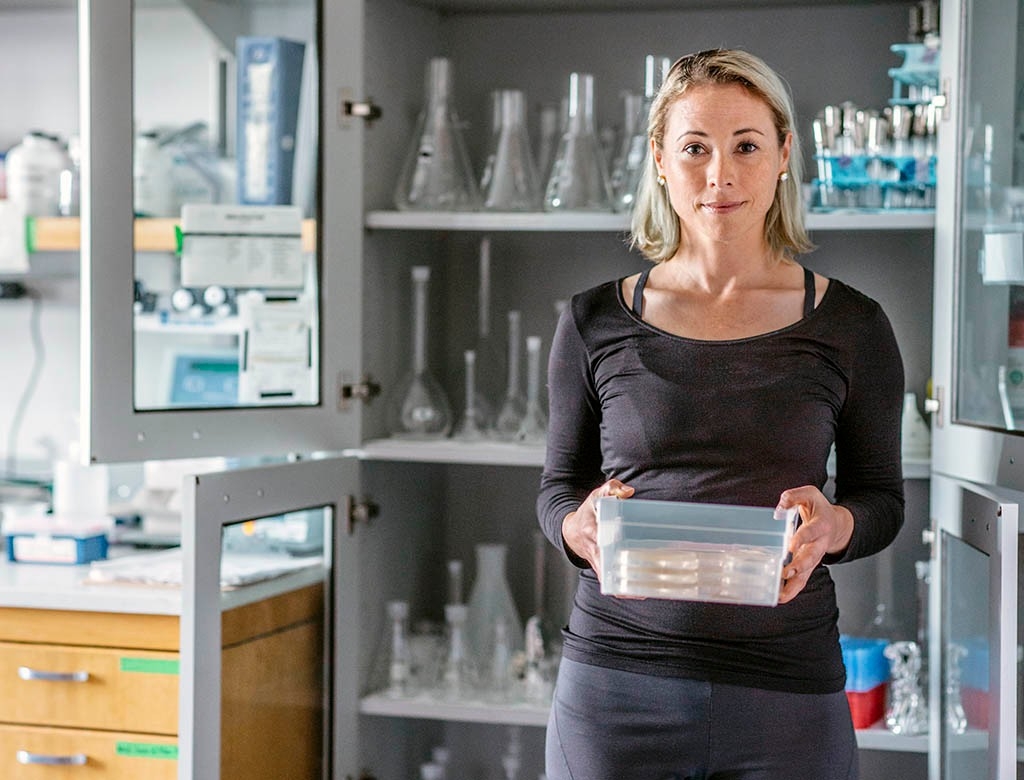
Engineering meets neuroscience
Although she works in a neuroscience lab, Franco is a mechanical engineering graduate student seeking a way to grow touch-sensitive neurons in a dish. Her hope is to open up new ways to study how touch works and why, sometimes, it doesn’t. Her desk sits by a window at the end of a long, black-topped lab bench, on top of which sit various pieces of equipment — beakers, petri dishes, microscopes and more.
Like most of her lab mates, she spends much of her time tending to her worms — keeping them warm or cold depending on the experiment, feeding them nonharmful E. coli bacteria, gingerly moving them from dish to dish with a hook purpose-built in the lab and staring at them through a microscope. She didn’t always imagine this life for herself. In addition to her research, she’s a competitive cyclist.
When I graduated from high school, I didn’t really have any college prospects, so I moved out of the house and I started working full time and living on my own. One time I was talking to some of my cyclist friends about bike fit and how awesome it is that we can adjust someone’s position on a bicycle to optimize their power output, and they were like, “Joy, you’re such a nerd. You have to go back to school. You have to get your degree.” I thought, “Oh, huh. Someone believes in me. Someone thinks that I am capable of achieving something like a bachelor’s degree.”
Looking at things under a microscope is my absolute favorite thing to do. When you’re on the microscope and you’re looking at the worms as they’re moving around, it is just beautiful. If you’re looking at it under a fluorescent microscope, it’s a glow worm that’s moving around. And I just can’t get past how awesome that is and how awesome it is that that’s my job — looking at really cool stuff through a microscope.
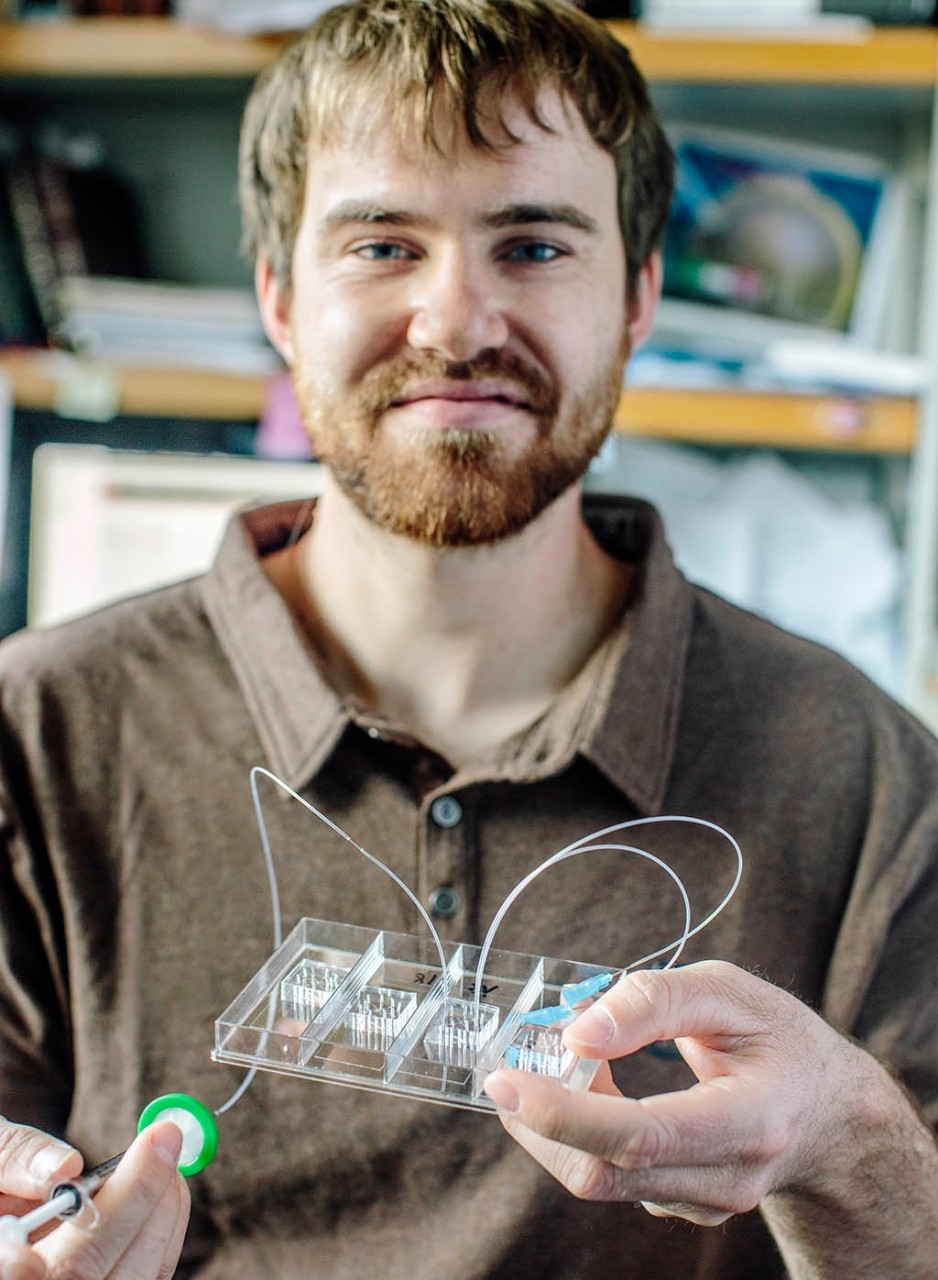
Science with a large-scale impact
Adam Nekimken, a mechanical engineering graduate student, is developing tiny mechanical devices that help researchers touch their worms in more controlled ways. On a typical morning in the lab, his first task is to check his devices and clean them out before a planned experiment. Now at the end of his graduate training, he is considering his next steps.
We do very basic biology research. I’m working on new devices and new methods for studying the worms. Those, in themselves, are not going to cure any diseases or anything, but you have to keep in mind the bigger picture: Maybe someone will see that and have an idea that leads them to some other insight that could end up helping people. And maybe not.
You’ll hear people talk about, “Why are we funding this and that stupid research when you could have just done this one that leads to some big thing?” But the problem is, we just don’t know that ahead of time. So we have to do all of this research and just try to understand the natural world, with the foreknowledge that someone, somewhere will have an important insight.
My plan is to go into industry, in part because I want to work on something that has an impact at a larger scale than doing university research. For me, the biggest result of doing my PhD — other than publishing some papers that may have some impact — is learning the process of thinking through this research and learning how to formulate experiments and perform them.
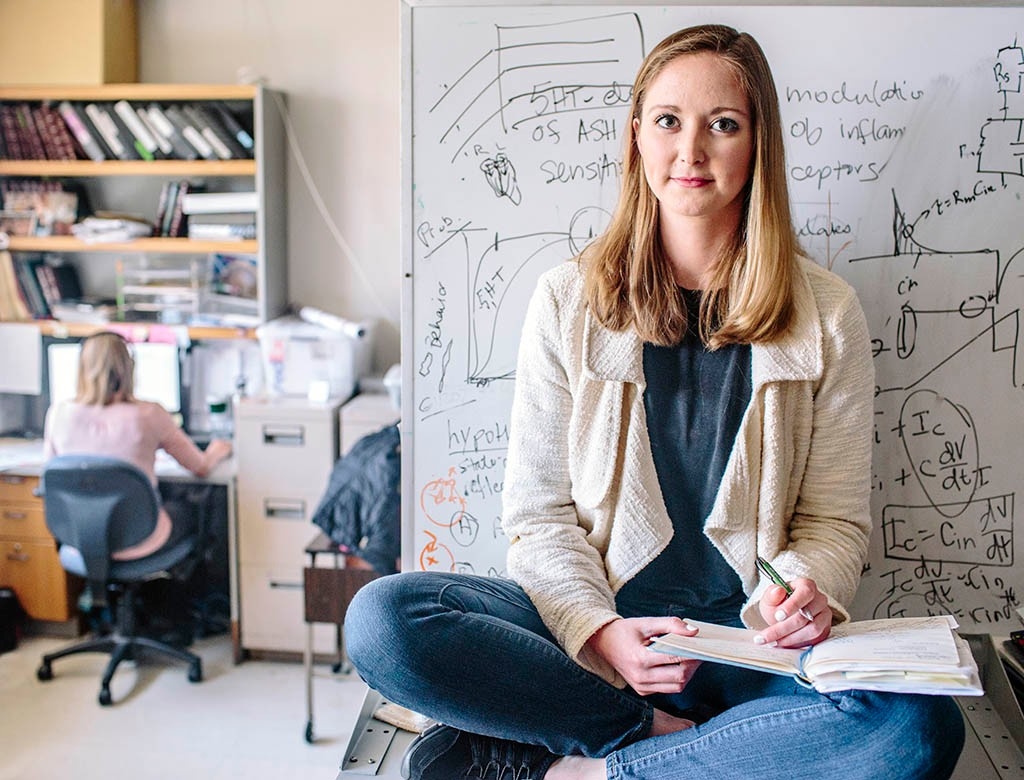
A passion for teaching
Dail Chapman, PhD, is a postdoctoral scholar. This afternoon, she prepares to check on her worms’ genetic makeup using a technique called gel electrophoresis. The first step: heating up the gel mixture in a microwave. Afterward, she lets the gel harden in a special electrified plate, deposits DNA samples at one end, turns on the electric current and waits for it to separate out bits of DNA by size, allowing her to compare her worms’ DNA to control samples.
Unlike many of her colleagues, Chapman came to the lab planning to one day teach science at a liberal arts college. A mug above her desk reads, “I became a teacher for the money and fame.” She had some trepidation about revealing her long-term plan when Goodman interviewed her for her current position in the lab.
I was super apprehensive about even bringing up teaching because I think, as scientists, the expectation is that you want to become a renowned researcher. So I was talking to my boss about how I should conduct the interview, and whether I should be honest about my career pursuits. And he told me, “No.”
But it just didn’t feel right to essentially lie to someone who may become my future boss. And it’s not in my character. So when she asked what I saw myself doing, I totally let my guard down and let my passion for teaching come through, and it was a super nerve-wracking moment. You would think that would be a problem. And instead, it wasn’t. She said, “No, I love teaching and I like to teach every chance I can get. I went to a small liberal arts college too, and I know what it’s like to be in that environment where teaching is at the center of the institution’s goals.”
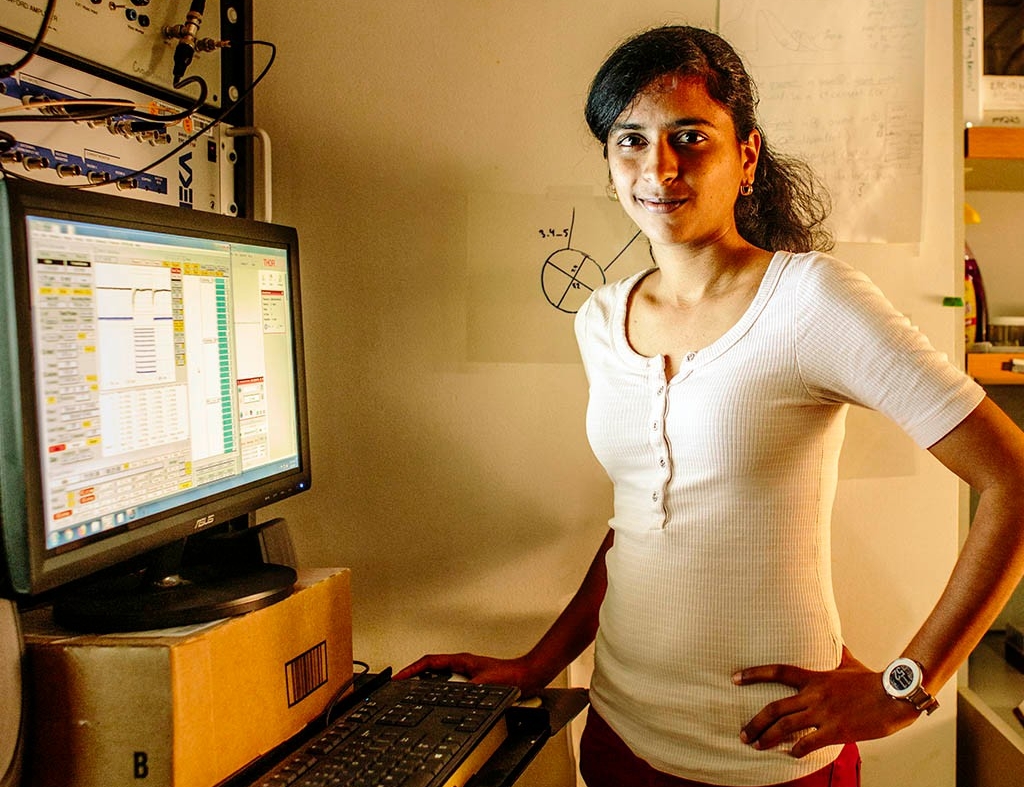
Making real-world connections
Sammy Katta, PhD, just completed her final year of the School of Medicine’s Neurosciences PhD Program. She spends some of her time helping out other lab members — among other things, she’s the resident scientific computing expert — but most of her days in the past few months have been spent writing and rewriting her thesis.
She knew from the start she might not stay in science that much longer. She’s also been looking for a job — not in academia, but in public policy.
I didn’t come in feeling like I definitely wanted to be a professor. I majored in molecular biology, but I also did a minor in global poverty and practice. I knew I was really interested in neuroscience and I thought I did enjoy doing neuroscience research, and so I came to grad school. At this point I don’t regret that. I have been happy, and it’s been really cool to be able to participate in the process of science. I’ve learned so much from it.
But I’ve also missed a little bit some of these other things, with policy or with working with an NGO or something like that. I felt like I needed to be able to more directly affect people’s lives to take advantage of the advances that science is making. I would like to do science, but there are other things I would like to do more for my next career step. I knew there were other routes and I wanted to be able to explore those.
Alternate paths
Goodman has also thought about what else, besides research, she might do.
“If I had known that industrial design was a thing that you could do, maybe I would have done that. If I had known you could be a software engineer without debugging code endlessly, I might have done that,” she said.
She’s not unhappy with what she’s doing, she said, but she wishes she had more time to spend in the lab.
So let me tell one little anecdote that relates to the lab that I worked in as a college student writing code. During the last summer I was in the lab, the lab head was dying of lung cancer.
The lab was actually physically in the hospital. He would come from his hospital bed — when he felt well enough to walk — to the lab to find out what we were doing because it made him happy, because it gave him joy, even though he was in enormous pain. There was something really powerful to see about that passion and connection that many scientists have to their work.
I don’t know if I’ve got as deep a connection as he did, but if I can rebuild that connection with the experimental work, I can imagine that.
Of course, those are not things Goodman or the members of her lab think about most of the time. At the end of the day, they have experiments to get done, and at the literal end of the day, it’s time to clean up.
Graduate student Katta is one of several people in the lab who tend to work late into the evening.
“I try to end on a good note, after I get a good recording or after I’m too tired to go for another hour,” Katta said. She shuts down her electronics, cleans up her equipment and takes some notes, and then that’s that — she says goodbye to anyone who’s still around, maybe grabs a snack on the way out the door and heads home.
Like most of the rest of her colleagues, she’ll wake up the next day and do it all again, until she’s ready to move on to what’s next.

